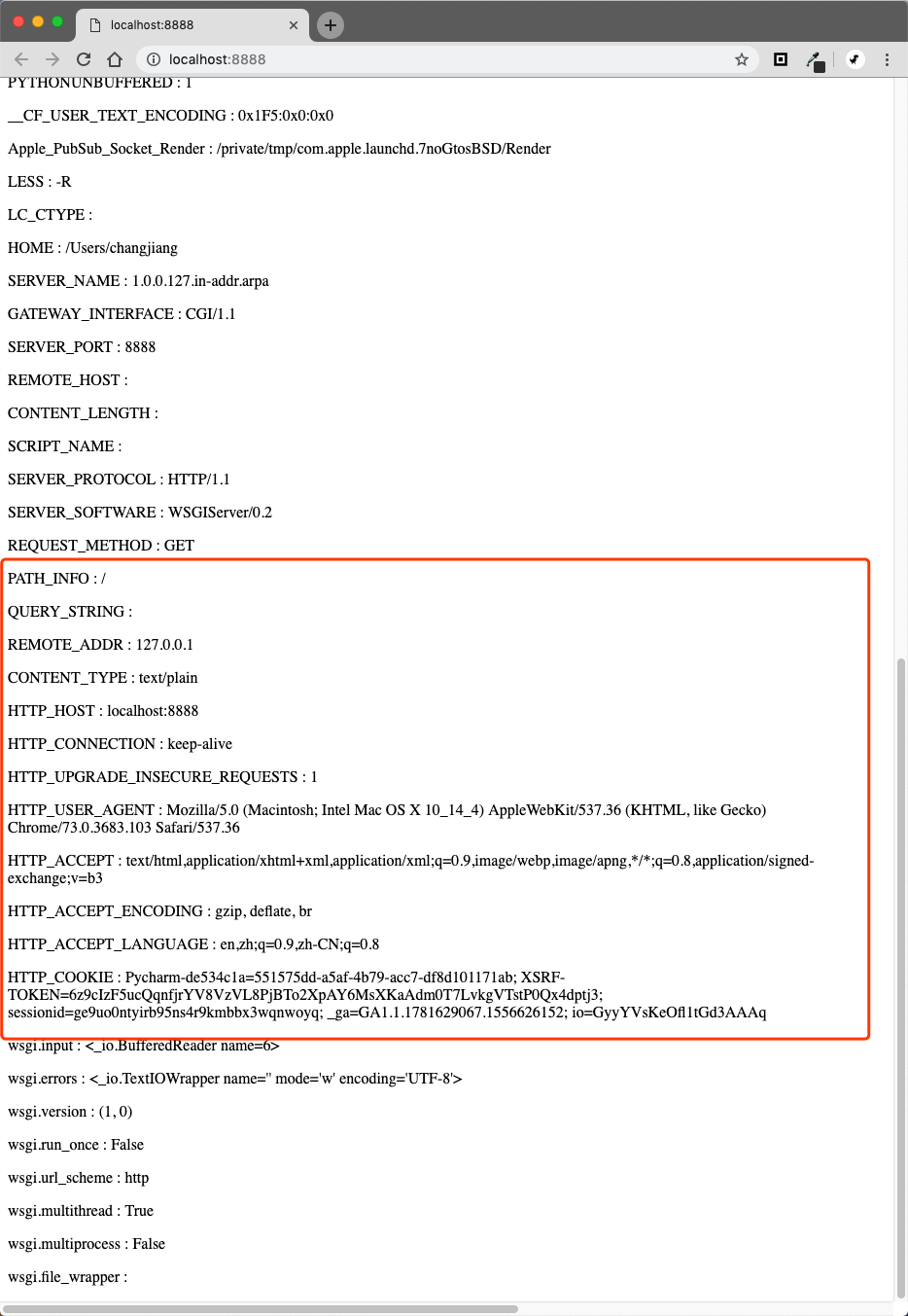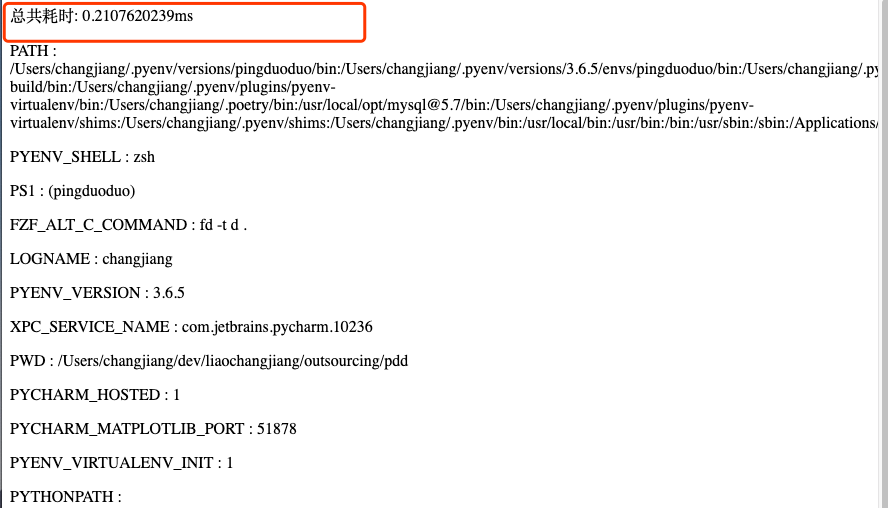本文参考了:
上篇文章简要提到:wsgi 规范中的 app 是一个可调用对象,可以通过嵌套调用的方式实现中间件的功能。这篇文章就来亲自动手实现一下。
此文的重点在于 app 端,所以 wsgi 服务器将使用python 内置module wsgiref.simple_server 中的make_server。
创建 app
新建文件 app.py :
def application(environ, start_response):
"""The web application."""
response_body = ""
for key, value in environ.items():
response_body += "<p>{} : {}\n</p>".format(key, value)
# Set up the response status and headers
status = '200 OK'
response_headers = [
('Content-Type', 'text/html; charset=utf-8'),
('Content-Length', str(len(response_body))),
]
start_response(status, response_headers)
return [response_body.encode('utf-8')]
注意:python3中要求
response_body是 bytes,所以需要 encode()一下。在 python2中是 str,不需要 encode()。
这个 app 做的事情非常简单,把传过来的 environ 原样返回。在开始返回body 之前,调用server传过来的start_response函数。
简要说明一下为什么是 retuen [response_body]而不是 return response_body或者 return response_body.split("\n")或者return response_body.split("")?
- 首先 wsgi 规范说明了
app返回的是一个可迭代对象,列表是可迭代的。 - 其次,对于大多数 app 来说,response_body都不会太长,服务器的内存完成足以一次性装下,所以最高效的方法就是一次性把
response_body全传过去。
创建 server
新建文件server.py
from wsgiref.simple_server import make_server
from app import application
print("Server is running at http://localhost:8888 . Press Ctrl+C to stop.")
server = make_server('localhost', 8888, application)
server.serve_forever()
用浏览器打开 http://localhost:8888,就可以看到 environ 的详细内容。其中比较重要的我用红框框圈了起来。

第一个中间件:cors
先简要了解一下 cors 的机制(详细的要比这个复杂点):
如果一个ajax请求(XMLHttpRequest)是跨域的,比如说在 http://localhost:9000页面上向运行在http://localhost:8888的服务器发起请求,浏览器就会往请求头上面加上一个ORIGIN字段,这个字段的值就是localhost:9000。(对应在app 的 environ 参数中,就是 HTTP_ORIGIN)
同时,浏览器会先发出OPTIONS请求,服务器要实现这样的功能:如果想要接收这个请求的话,需要在response 的 headers里面添加一个Access-Control-Allow-Origin字段,值就是请求传过来的那个ORIGIN。
浏览器发出OPTIONS请求并发现返回数据的 headers 里面有Access-Control-Allow-Origin,才会进行下一步发出真正的请求:GET,POST,WAHTERVER。
所以,CORS 是浏览器和 Server共同协作来完成的。
看一下代码:
class CORSMiddleware(object):
def __init__(self, app, whitelist=None):
"""Initialize the middleware for the specified app."""
if whitelist is None:
whitelist = []
self.app = app
self.whitelist = whitelist
def validate_origin(self, origin):
"""Validate that the origin of the request is whitelisted."""
return origin and origin in self.whitelist
def cors_response_factory(self, origin, start_response):
"""Create a start_response method that includes a CORS header for the
specified origin."""
def cors_allowed_response(status, response_headers, exc_info=None):
"""This wraps the start_response behavior to add some headers."""
response_headers.extend([('Access-Control-Allow-Origin', origin)])
return start_response(status, response_headers, exc_info)
return cors_allowed_response
def cors_options_app(self, origin, environ, start_response):
"""A small wsgi app that responds to preflight requests for the
specified origin."""
response_body = 'ok'
status = '200 OK'
response_headers = [
('Content-Type', 'text/plain'),
('Content-Length', str(len(response_body))),
('Access-Control-Allow-Origin', origin),
('Access-Control-Allow-Headers', 'Content-Type'),
]
start_response(status, response_headers)
return [response_body.encode('utf-8')]
def cors_reject_app(self, origin, environ, start_response):
response_body = 'rejected'
status = '200 OK'
response_headers = [
('Content-Type', 'text/plain'),
('Content-Length', str(len(response_body))),
]
start_response(status, response_headers)
return [response_body.encode('utf-8')]
def __call__(self, environ, start_response):
"""Handle an individual request."""
origin = environ.get('HTTP_ORIGIN')
if origin:
if self.validate_origin(origin):
method = environ.get('REQUEST_METHOD')
if method == 'OPTIONS':
return self.cors_options_app(origin, environ, start_response)
return self.app(
environ, self.cors_response_factory(origin, start_response))
else:
return self.cors_reject_app(origin, environ, start_response)
else:
return self.app(environ, start_response)
__init__方法传入的参数有:下一层的 app(回顾一下前面说的 app 是一层一层的,所以能够实现中间件)和 client 白名单,只允许来自这个白名单内的ajax 请求。
__call__方法说明这是一个可调用对象(类也可以是可调用的),一样接收两个参数:environ和start_response。首先判断一下 environ 中有没有HTTP_ORIGIN,有的话就表明属于跨域请求。如果是跨域,判断一下 origin 在不咋白名单。如果在白名单里面,如果是 OPTIONS请求,返回cors_options_app里面的对应内容(加上了Access-Control-Allow-Origin header);如果不是OPTIONS请求,调用下一层的 app。如果不在白名单,返回的是cors_reject_app。
修改一下server.py:
app = CORSMiddleware(
app=application,
whitelist=[
'http://localhost:9000',
'http://localhost:9001'
]
)
server = make_server('localhost', 8000, app)
测试 cors app
这里在运行三个客户端,[代码在此]。(github.com/liaochangji…)
运行python client.py:

在浏览器打开http://localhost:9000、http://localhost:9001和http://localhost:9002,可以发现http://localhost:9000和http://localhost:9001成功发出了请求,而http://localhost:9002失败了。


第二个中间件:请求耗时
这个比上一个要简单很多,相信现在你已经完全能够理解了:
import time
class ResponseTimingMiddleware(object):
"""A wrapper around an app to print out the response time for each
request."""
def __init__(self, app):
self.app = app
def __call__(self, environ, start_response):
"""Meaure the time spent in the application."""
start_time = time.time()
response = self.app(environ, start_response)
response_time = (time.time() - start_time) * 1000
timing_text = "总共耗时: {:.10f}ms \n".format(response_time)
response = [timing_text.encode('utf-8') + response[0]]
return response
再修改一下server.py:
app = ResponseTimingMiddleware(
CORSMiddleware(
app=application,
whitelist=[
'http://localhost:9000',
'http://localhost:9001'
]
)
)
再次访问http://localhost:8000,会看到最前面打印出了此次请求的耗时:

总结一下
我手画了一个请求图,希望对你有所帮助:

本文的所有源代码开源在 github 上:github.com/liaochangji…
希望能点个 star ~

如果你像我一样真正热爱计算机科学,喜欢研究底层逻辑,欢迎关注我的微信公众号:
